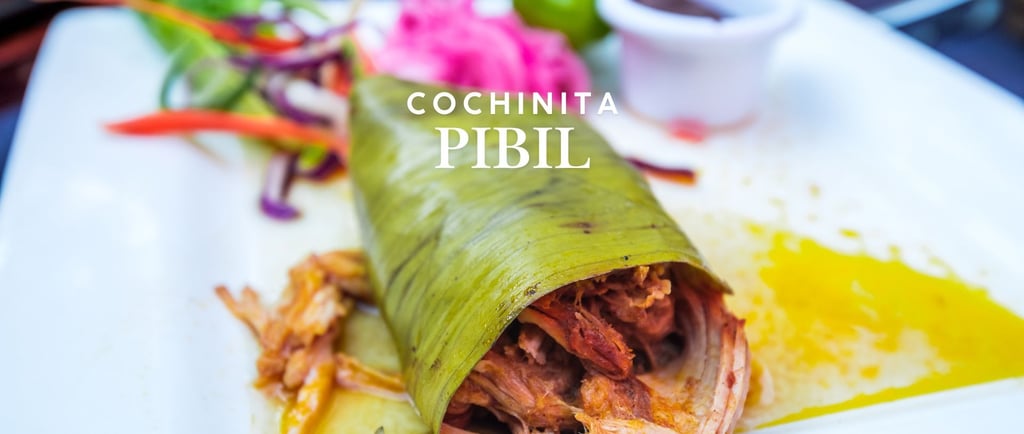Cochinita Pibil: The Red Heart of Yucatecan Cuisine
This article delves into the history, local ingredients, and traditional recipe of cochinita pibil, one of the most iconic dishes in Yucatecan cuisine. From its ancestral origins in ancient Maya earth ovens to its place in the contemporary kitchens of Tulum, discover how achiote, sour orange, and banana leaves bring this flavorful, cultural, and traditional delicacy to life.
RECETASCOCINA LOCAL Y ANCESTRALINGREDIENTES DE LA REGION
Ro Madrid
6/25/20253 min read


Cochinita Pibil: The Red Heart of Yucatecan Cuisine
In the depths of the Mayan world, among green jungles and red lands, one of the most emblematic dishes of Mexican cuisine was born: cochinita pibil. Its name evokes fire, earth, tradition, and celebration. It is an ancestral recipe that has transcended generations and borders, carrying with it the deep flavor of the Yucatán Peninsula.
Today, in restaurants and kitchens in Tulum, cochinita pibil remains alive as a symbol of cultural identity, a dish that honors the memory of a people and exalts the richness of its local ingredients.
Origin and History of the Dish
The word pibil comes from the Mayan pib, which means "buried". The traditional cooking method consisted of baking the meat underground, in a stone oven called pib, covering it with banana leaves and burning embers. This slow cooking technique, along with achiote marinade and sour orange juice, resulted in tender, juicy, and deeply aromatic meat.
Originally, this dish was prepared with venison or wild boar, but with the arrival of the Spaniards, pork was introduced, which adapted perfectly to this recipe.
Local Ingredients, Soul of the Flavor
Cochinita pibil is much more than marinated pork. It is a symphony of ingredients that only the Yucatán land can offer:
Achiote (Bixa orellana): Sacred seed that gives an intense red color and an earthy, slightly citrus flavor. It is mixed into a paste with spices and vinegar.
Sour orange: Acidic and aromatic juice that balances the marinade and adds freshness. It is used in the marinade and for accompaniment.
Pork meat: Preferably leg or shoulder, due to its natural fat and tender texture.
Banana leaves: Provide aroma and retain moisture during cooking. They are also used to serve tamales or wrap the meat.
Red onion: Pickled with lime, vinegar, and oregano. Adds crunch and acidity.
Habanero chili: Served in fresh or roasted sauces for those seeking a touch of traditional spiciness.
🍽️ Traditional Cochinita Pibil Recipe
Ingredients (for 6 people):
1.5 kg of pork shoulder or leg cut into large pieces
100 g of achiote paste
1 cup of sour orange juice (or a mix of sweet orange with lime and vinegar)
4 cloves of garlic
1 tablespoon of dried oregano
1 teaspoon of ground cumin
Salt and pepper to taste
Banana leaves (passed over fire to soften)
1 red onion (for pickling)
1/2 cup of white vinegar
1 habanero chili (optional)
Preparation:
Marinate the pork: Blend the achiote paste with the sour orange juice, garlic, oregano, cumin, salt, and pepper. Cover the meat with this mixture and let it rest for at least 4 hours (ideally overnight).
Prepare the oven or container: In a baking dish or large pot, place banana leaves as a base. Add the marinated meat and cover it with more leaves.
Slow cook: Bake at 160°C for 3–4 hours, until the meat easily falls apart. It can also be done in a slow cooker or, if you have a pib, buried with embers as in ancient times!
Prepare the pickled onion: Slice the red onion and soak it in vinegar with salt, lime juice, and oregano. Let it rest for at least 1 hour.
Serve: Shred the meat and serve it hot over corn tortillas, with pickled onion and, if you like, habanero chili sauce.
Variations and Contemporary Uses
Traditional cochinita pibil is served in tacos, tortas, or over white rice. However, its flavor has inspired contemporary chefs to reinvent it in:
Tamales filled with cochinita
Caribbean empanadas
Gourmet croquettes or sliders
Tostadas with avocado foam and cochinita
Noodles with pibil broth and quail egg
Many restaurants in Tulum reinterpret this classic in vegan versions, using mushrooms, jackfruit, or textured soy, maintaining the original marinade.
A Dish with Soul
Eating cochinita pibil is to savor history, territory, and culture. It is to share a tradition that remains alive, that has withstood the test of time and that is renewed in every kitchen of the region.
In Tulum, from street stalls to Michelin-recognized restaurants, cochinita remains a protagonist. A symbol of Yucatecan pride, and a perfect example of how ancestral flavors continue to shape Mexico's identity.
"Cochinita is not only cooked… it is honored."






